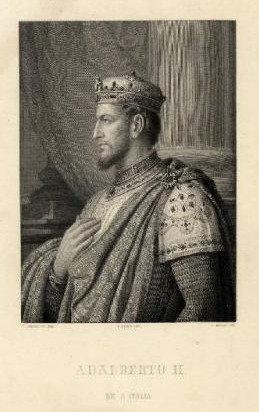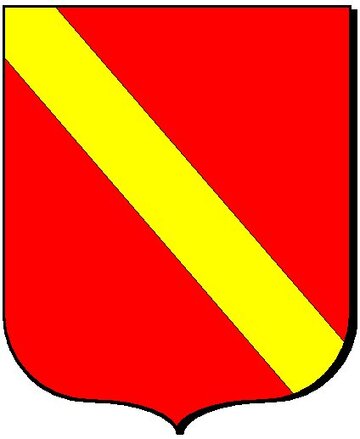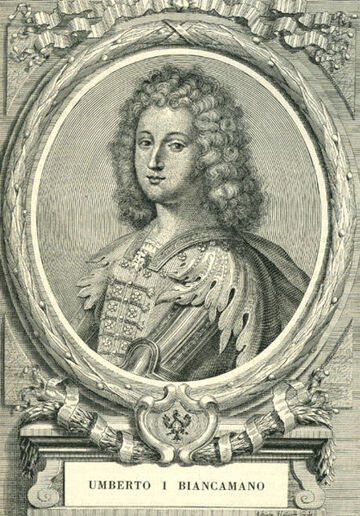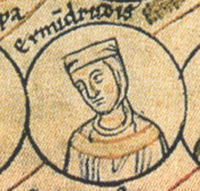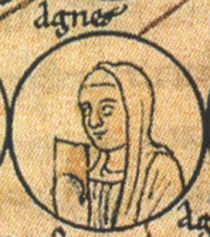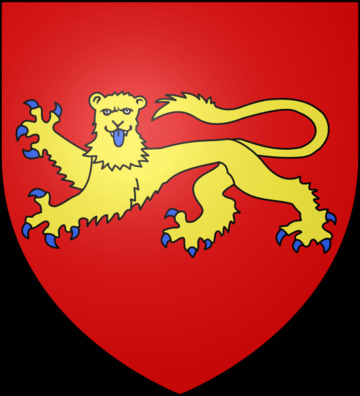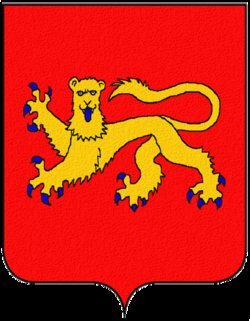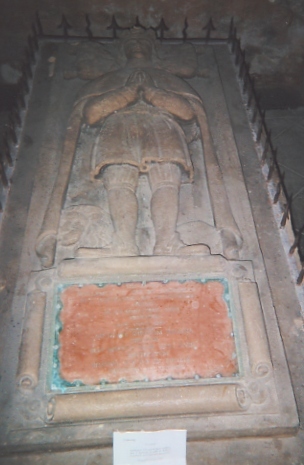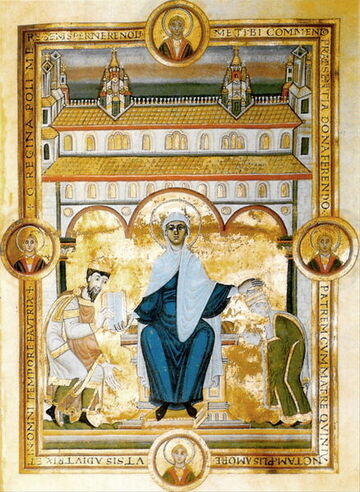maximum test » Agnès "of Burgundy" (± 995-1068)
Personal data Agnès "of Burgundy"
Source 1- Alternative name: Agnes of Gévaudan
- Nickname is of Burgundy.
- She was born about 995 in Bourgogne, France.
- She was christened in first wife.
- Alternative: She was christened in wife of, William, Duke of, Aquitaine.
- Alternative: She was christened in first wife.
- Alternative: She was christened in wife of, William, Duke of, Aquitaine.
- Alternative: She was christened in first wife.
- Alternative: She was christened in wife of, William, Duke of, Aquitaine.
- Alternative: She was christened in the year 995 in (alternate birth date).
- Profession: Comtesse, de Bourgogne, d'Anjou.
- She died on November 10, 1068 in Charente Maritime Poitou-CharentesSaintes
Nouvelle-Aquitaine France. - She is buried on November 10, 1068Poitiers, Priory of Saint-Nicolas.
- A child of Otto Guillaume I Vilim Guglielmo di Ivrea and Ermentrude (Irmtrude) de Roucy
Household of Agnès "of Burgundy"
She is married to William 'the Grand' of Aquitaine.
They got married in the year 1018 at Poitiers,Vienne,France.
Child(ren):
Notes about Agnès "of Burgundy"
GIVN Agnes Countess Of
SURN Burgundy
AFN 9HMJ-6J
DATE 9 SEP 2000
TIME 13:15:34
GIVN Agnes Countess Of
SURN Burgundy
AFN 9HMJ-6J
DATE 9 SEP 2000
TIME 13:15:34
Almodis var datter til vicompte Gerard av Limoges.
[2627] EDWARD3.TXT Agnes Countess of BURGUNDY (995-1068)
[2640] WSHNGT.ASC file (Geo Washington Ahnentafel) # 8725049, d 1107/1011
NOTE
GEDCOM created by TMG...
GIVN Agnes Countess Of
SURN Burgundy
AFN 9HMJ-6J
DATE 9 SEP 2000
TIME 13:15:34
#Générale##Générale#Comtesse de Bourgogne
{geni:about_me} http://finnholbek.dk/genealogy/getperson.php?personID=I12502&tree=2
Daughter of '''Otto-Guillaume, Comte de Bourgogne''' and '''Ermentrude de Roucy'''
m firstly (1019) as his third wife, '''GUILLAUME III "le Grand" Comte de Poitou, GUILLAUME V Duke of Aquitaine''' ([969]-Abbaye de Maillezais 31 Jan 1030). Children:
* '''Peter William, later duke as William VII'''
* '''Guy Geoffrey, later duke as William VIII'''
* '''Agnes (or Ala)''', married Henry III, Holy Roman Emperor (1043)
m secondly (1 Jan 1032, divorced [1049/52]) as his first wife, '''GEOFFROY II "Martel" Comte d'Anjou'''.
'''Foundation for Medieval Genealogy''':
'''AGNES de Mâcon''' ([990/95]-Saintes 10 Nov 1068, bur Poitiers, Priory of Saint-Nicolas). Agnes is named as daughter of "Ermentrudis" in the Continuator of Flodoard, which specifies that she was mother of "Wido"[854]. Her birth date range is estimated on the basis of the estimated birth date range of her mother. Rodulfus Glaber states that "Willemus…Pictauensis" married one of the daughters of "Willemus, Henrici ducis priuignus, Adalberti Longobardorum ducis filius" & his wife[855]. "Agnes comitissa filia Ottonis cognomento Willelmi comitis Matiscensis, uxor…Wilelmi ducis Aquitanorum" donated property to Cluny by charter dated [1020][856]. The Chronico Sancti Michaelis records that "Gaufredus Martellus Andegavensis comes" married "Agnetem comitissam Pictavensem" incestuously in 1032[857]. The Chronicæ Sancti Albini records the marriage "1032 Kal Jan" of "Gaufridus comes, Agnetem comitissam incesto", indirectly indicating her origin in a later passage which records the marriage "1043 XII Nov" of "Hainricus imperator [et] filiam Agnetis comitissæ"[858]. Her origin is clarified by the Chronicæ Sancti Albini which records the marriage "1043 XII Kal Nov…apud Vesbrianim" of "Henricus imperator…filiam Willelmi comitis Pictavorum et Agnetis"[859]. Geoffroy Comte d'Anjou & his wife founded the abbey of La Trinité de Vendôme by charter dated 31 May 1040, signed by "Goffridi comitis Andegavorum, Agnetis conjugis suæ…"[860]. A powerful personality, she succeeded in defeating her stepson Duke Eudes and installing her own son as Duke of Aquitaine, Comte de Poitou. Regent of Aquitaine for her son 1039-1044. She arranged her daughter's marriage with Emperor Heinrich III in 1043 and lived at the imperial court after this time. "Goffredus…comes atque Agnes…uxor" donated property to the monks of La Trinité, Vendôme by charter dated 6 Jan 1049 subscribed by "Willelmi ducis Aquitanorum, Goffredi pueri fratris illius"[861]. "Gaufredus Andegavorum comes…uxor mea Agnes" made a donation to the priory of Saint-Nicholas de Poitiers by undated charter which also names "eius [Agnetis] filii comites…Pictavenses"[862]. A charter dated to [1060/67] recites a prior donation to Saint-Aubin d'Angers by "Hildegardis comitissa", who retained a life interest in the property which, after the death of the donor, was sold in turn to "Agneti comitissa" (recording her divorce from "comitum Gaufridum"), "comitem Gaufridum…Gaufridi nepotem" and finally "fratre eius Fulconi" who restored it to the abbey[863]. After her separation from her second husband, in 1047 she founded the abbey of Notre-Dame de Saintes, where she became a nun in 1068[864]. "Agnes" founded the abbey of Saint-Nicolas at Poitou with the consent of "ambobus filiis Guillelmi et Gauffrido" by charter dated [1050][865]. "Aquitanorum…dux Gaufridus" confirms in his charter dated [1058/68] that "mea mater Agnes…frater meus Guillelmus" were both buried in the priory of Saint-Nicolas de Poitiers[866]. The necrology of Vendôme La Trinité records the death "IV Id Nov" of "Agnes comitissa"[867].
m firstly (1019) as his third wife, GUILLAUME III "le Grand" Comte de Poitou, GUILLAUME V Duke of Aquitaine, son of GUILLAUME IV "Fier-à-Bras" Duke of Aquitaine [GUILLAUME II Comte de Poitou] & his wife Emma de Blois ([969]-Abbaye de Maillezais 31 Jan 1030).
m secondly (1 Jan 1032, divorced [1049/52]) as his first wife, GEOFFROY d'Anjou, son of FOULQUES III "Nerra" Comte d'Anjou & his second wife Hildegarde [de Metz] (14 Oct 1006-9 Sep 1067). He succeeded his father in 1040 as GEOFFROY II "Martel" Comte d'Anjou.
--------------------
She became the third wife of Guillaume III-V, Duke of Aquitaine, one of the most powerful lords in France. After about twelve years of marriage, Guillaume died and Agnes defeated his two sons from a previous marriage. First she ruled by herself, then later with her own two sons. She married again but her second husband, the Count of Anjou, divorced her after eighteen years.
=-------------------- =
http://en.wikipedia.org/wiki/Agnes_of_Burgundy,_Duchess_of_Aquitaine
'''Agnes of Burgundy, Duchess of Aquitaine'''
Countess of Anjou
==Spouses==
* William V, Duke of Aquitaine
* Geoffrey II, Count of Anjou
==Issue==
William VII, Duke of Aquitaine
William VIII, Duke of Aquitaine
Agnes, Holy Roman Empress
Father Otto-William, Count of Burgundy
Mother Ermentrude of Rheims
Born Burgundy
Died 10 November 1068
Agnes of Burgundy or Agnes de Macon, Duchess of Aquitaine (?- 10 November 1068[1]), was a daughter of Otto-William, Count of Burgundy and Ermentrude of Roucy. She was a member of the House of Ivrea.
==Life==
We do not know the date of birth of Agnes but it is probably shortly before the year 1000[2]. Agnes' father was the son of Adalbert of Italy.
In 1019, she married Duke William V of Aquitaine by whom she had three children: William VII, Duke of Aquitaine, William VIII, Duke of Aquitaine and Agnes, Holy Roman Empress. William died on January 31, 1030, leaving his widow and their three young children, plus the three surviving children from his first two marriages.
After her husband's death, Agnes lost her influence at the court of Poitiers since her sons were not heirs. In order for her to regain her position and ensure a future for her children, Agnes had to remarry. Thus she married Geoffrey II, Count of Anjou which was an attractive offer because his father was the powerful Fulk III, Count of Anjou.
In 1033, Geoffrey's troops invaded Poitou with the support of Agnes. William VI, Duke of Aquitaine the new Count of Poitou, was captured in March. He was released only in 1036 against a large ransom and he died in 1038 without children. The county then returns to his brother, Agnes' stepson Odo of Gascony, who was already Duke of Gascony. He went to war against Agnes, her husband and sons. Odo was killed at the battle at Mauzé.
The succeeding Count of Poitou was Agnes's son, Peter, who took the name of William VII Aigret. Being too young, her mother governed territories in his place from 1039 to 1044 and indeed it even seems the government itself, without her husband. When she transmitted the power to William, she married and took the opportunity to give his second son, Geoffrey Guy of the duchy of Gascony, by marrying an heiress. Agnes then joined Geoffrey in Anjou and if it does not participate actively in government, certainly some influence on him.
Agnes and Geoffrey stayed in Duitsland at the imperial court, so her daughter Agnes could marry Henry III, Holy Roman Emperor. They then bonded with the imperial couple, a trip to Italy where they participated in the council of Sutri filing and inducts two popes Pope Clement II, who is quick to crown the emperor and empress. After a pilgrimage to Monte Garaño, the couple went back to Poitou in 1047 where they founded the Abbey of Our Lady and Sacred. Between 1047 and 1049, Agnes founded the abbey of Saint Nicolas de Poitiers.
Between 1049 and 1052, Agnes and Geoffrey separate. The reasons are varied: the most logical is the absence of children, however we must not forget that the council of Reims from 1049 condemns certain marriages as incestuous and judged them in part, in addition, Geoffrey went to war against the King of France who appreciated the little freedom that will take his vassal to Duitsland (it seems that Geoffrey had the project to swear allegiance to the emperor and to no longer depend on the King of France) and it is very possible that King has imposed on his vanquished vassal to divorce his wife. Indeed, Agnes also influenced her husband, but she came from Burgundy and had been retained strong links with her homeland, so it seemed that it was Agnes who wanted the divorce.
Still, Agnes returned to the court of Poitiers to her son William to who she has much influence. A war soon broke out between Anjou and Poitou, which saw a victory for Geoffrey in 1053. This would have probably never happened if Agnes never divorced Geoffrey. In 1058 William left for another war against his former stepfather Count of Anjou, probably because Geoffrey gave the dowry of Agnes to his new wife, Adelaide. William was on the verge of winning when he died of an illness in 1058.
He was succeeded his brother, Geoffrey Guy, who took the dynastic name of William VIII. The young count had remained close to Geoffrey because he was the only father figure he knew and he reconciled with Anjou. But only during Geoffrey's lifetime, in fact, after his Geoffrey's death, William did not hesitate to attack his heirs and assume control of Saintonge from 1062. Agnes, despite her retirement, was still very active and did not hesitate to travel throughout Poitou to participate in donations or simply see her son at the court of Poitiers. Agnes died on 10 November 1068. She is buried at St. Nicolas de Poitiers.
See also
* County of Burgundy
* Dukes of Burgundy family tree
==References==
1. ^ Agnes of Burgundy, Roots Web
2. ^ BURGUNDY DUCHY NOBILITY, Medieval Lands
==Sources==
* Michel Dillange, The Comtes de Poitou, Dukes of Aquitaine (778-1204), Geste editions, al. "The Nativity", 1995, 304p. (ISBN 2-910919-09-9) .
* Olivier Guillot, Count of Anjou and his entourage at XIecentury, Editions Picard, Paris, 1972 .
* Penelope D. Johnson, "Agnes of Burgundy: an eleventh-century monastic woman as boss"InJournal of Medieval History, June 1989 .
* Alfred Richard History of the Counts of Poitou, vol.1, Paris, 1903 .
* Isabelle Soulard-Berger, "Agnes of Burgundy, Duchess of Aquitaine and Countess of Anjou. Implement political and religious action (1019-c. 1068)"In bulletin of the Antiquarian Society of the West, vol.VI, 1er quarter 1992 .
This page was last modified on 3 July 2010 at 12:23.
=-------------------- =
'''William V of Aquitain'''e
From Wikipedia, the free encyclopedia
His third wife was '''Agnes of Burgundy''', daughter of Otto-William, Duke of Burgundy. Her second husband was '''Geoffrey II of Anjou'''. They had two sons and a daughter also:
'''Peter William, later duke as William VII'''
'''Guy Geoffrey, later duke as William VIII'''
'''Agnes (or Ala)''', married Henry III, Holy Roman Emperor (1043)
=-------------------- =
--------------------
http://en.wikipedia.org/wiki/Agnes_of_Burgundy,_Duchess_of_Aquitaine
Agnes of Burgundy (or Agnes de Macon), Duchess of Aquitaine (died 10 November 1068) was a daughter of Otto-William, Count of Burgundy and Ermentrude of Roucy. She was a member of the House of Ivrea.
Life
We do not know the date of the birth of Agnes but it is probably shortly before the year 1000.[2] Agnes' father was the son of Adalbert of Italy.
First Marriage: Duchess of Aquitaine
In 1019, she married Duke William V of Aquitaine by whom she had three children: William VII, Duke of Aquitaine, William VIII, Duke of Aquitaine and Agnes, Holy Roman Empress. William died on January 31, 1030, leaving his widow and their three young children, plus the three surviving children from his first two marriages.
Second Marriage: Countess of Anjou
After her husband's death, Agnes lost her influence at the court of Poitiers since her sons were not heirs. In order for her to regain her position and ensure a future for her children, Agnes had to remarry. Thus she married Geoffrey II, Count of Anjou which was an attractive offer because his father was the powerful Fulk III, Count of Anjou.
In 1033, Geoffrey's troops invaded Poitou with the support of Agnes. William VI, Duke of Aquitaine the new Count of Poitou, was captured in March. He was released only in 1036 against a large ransom and he died in 1038 without children. The county then returned to his brother, Agnes' stepson Odo of Gascony, who was already Duke of Gascony. He went to war against Agnes, her husband and sons. Odo was killed at the battle at Mauzé.
Regency
The succeeding Count of Poitou was Agnes's son, Peter, who took the name of William VII Aigret. Being too young, his mother governed territories in his place from 1039 to 1044 and indeed it even seems the government itself, without her husband. When she transmitted the power to William, she married and took the opportunity to give his second son, Geoffrey Guy the duchy of Gascony, by marrying an heiress. Agnes then joined Geoffrey in Anjou and although she may not have actively participated in the government, certainly had some influence on him.
Agnes and Geoffrey stayed in Duitsland at the imperial court, so her daughter Agnes could marry Henry III, Holy Roman Emperor. They then bonded with the imperial couple, during a trip to Italy where they participated in the council of Sutri, filing and inducting two popes Pope Clement II, who was quick to crown the emperor and empress. After a pilgrimage to Monte Garaño, the couple went back to Poitou in 1047 where they founded the Abbey of Our Lady and Sacred. Between 1047 and 1049, Agnes founded the abbey of Saint Nicolas de Poitiers.
Separation from Geoffrey
Between 1049 and 1052, Agnes and Geoffrey separated. The reasons are varied: the most logical is the absence of children, however we must not forget that the council of Reims in 1049 condemned certain marriages as incestuous and judged them to part; in addition, Geoffrey went to war against the King of France who appreciated the little freedom from war that would take his vassal to Duitsland (it seems that Geoffrey had to swear allegiance to the emperor and to no longer depend on the King of France) and it is very possible that the King imposed on his vanquished vassal that he should divorce his wife. Indeed, Agnes also influenced her husband, but she came from Burgundy and had retained strong links with her homeland, so it may be that it was Agnes who wanted the divorce.
Later life
Still, Agnes returned to the court of Poitiers and her son William over whom she had much influence. A war soon broke out between Anjou and Poitou, which saw a victory for Geoffrey in 1053. This would have probably never happened if Agnes had not divorced Geoffrey. In 1058 William left for another war against his former stepfather Count of Anjou, probably because Geoffrey gave the dowry of Agnes to his new wife, Adelaide. William was on the verge of winning when he died of an illness in 1058.
He was succeeded by his brother, Geoffrey Guy, who took the dynastic name of William VIII. The young count had remained close to Geoffrey because he was the only father figure he knew and he reconciled with Anjou. But only during Geoffrey's lifetime, in fact, after Geoffrey's death, William did not hesitate to attack his heirs and assume control of Saintonge from 1062. Agnes, despite her retirement, was still very active and did not hesitate to travel throughout Poitou to participate in donations or simply see her son at the court of Poitiers. Agnes died on 10 November 1068. She is buried at St. Nicolas de Poitiers.
--------------------
Countess Agnaes de Bourgogne was born in 0987, lived in Bourgogne, France and died on 10 Nov 1068 .
Countess Agnaes married Duke Guillaume V (III) "The Grand" of Aquitaine before Mar 1018. Duke Guillaume was born in 0975, lived in Poitiers, Aquitaine, France. He was the son of Guillaume IV Aquitaine and Countess Emma of Champagne. He died on 31 Jan 1030 in France .
See of Aquitaine family for children.
--------------------
House of Burgundy
FatherRobert I, Duke of Burgundy
MotherErmengarde of Anjou
Bornc. 1056
Died1104
--------------------
Agnès de Bourgogne
Daughter of Otto-Guillaume, Comte de Bourgogne and Ermentrude de Roucy
m firstly (1019) as his third wife, GUILLAUME III "le Grand" Comte de Poitou, GUILLAUME V Duke of Aquitaine ([969]-Abbaye de Maillezais 31 Jan 1030). Children:
Peter William, later duke as William VII
Guy Geoffrey, later duke as William VIII
Agnes (or Ala), married Henry III, Holy Roman Emperor (1043)
m secondly (1 Jan 1032, divorced [1049/52]) as his first wife, GEOFFROY II "Martel" Comte d'Anjou.
Foundation for Medieval Genealogy:
AGNES de Mâcon ([990/95]-Saintes 10 Nov 1068, bur Poitiers, Priory of Saint-Nicolas). Agnes is named as daughter of "Ermentrudis" in the Continuator of Flodoard, which specifies that she was mother of "Wido"[854]. Her birth date range is estimated on the basis of the estimated birth date range of her mother. Rodulfus Glaber states that "Willemus…Pictauensis" married one of the daughters of "Willemus, Henrici ducis priuignus, Adalberti Longobardorum ducis filius" & his wife[855]. "Agnes comitissa filia Ottonis cognomento Willelmi comitis Matiscensis, uxor…Wilelmi ducis Aquitanorum" donated property to Cluny by charter dated [1020][856]. The Chronico Sancti Michaelis records that "Gaufredus Martellus Andegavensis comes" married "Agnetem comitissam Pictavensem" incestuously in 1032[857]. The Chronicæ Sancti Albini records the marriage "1032 Kal Jan" of "Gaufridus comes, Agnetem comitissam incesto", indirectly indicating her origin in a later passage which records the marriage "1043 XII Nov" of "Hainricus imperator [et] filiam Agnetis comitissæ"[858]. Her origin is clarified by the Chronicæ Sancti Albini which records the marriage "1043 XII Kal Nov…apud Vesbrianim" of "Henricus imperator…filiam Willelmi comitis Pictavorum et Agnetis"[859]. Geoffroy Comte d'Anjou & his wife founded the abbey of La Trinité de Vendôme by charter dated 31 May 1040, signed by "Goffridi comitis Andegavorum, Agnetis conjugis suæ…"[860]. A powerful personality, she succeeded in defeating her stepson Duke Eudes and installing her own son as Duke of Aquitaine, Comte de Poitou. Regent of Aquitaine for her son 1039-1044. She arranged her daughter's marriage with Emperor Heinrich III in 1043 and lived at the imperial court after this time. "Goffredus…comes atque Agnes…uxor" donated property to the monks of La Trinité, Vendôme by charter dated 6 Jan 1049 subscribed by "Willelmi ducis Aquitanorum, Goffredi pueri fratris illius"[861]. "Gaufredus Andegavorum comes…uxor mea Agnes" made a donation to the priory of Saint-Nicholas de Poitiers by undated charter which also names "eius [Agnetis] filii comites…Pictavenses"[862]. A charter dated to [1060/67] recites a prior donation to Saint-Aubin d'Angers by "Hildegardis comitissa", who retained a life interest in the property which, after the death of the donor, was sold in turn to "Agneti comitissa" (recording her divorce from "comitum Gaufridum"), "comitem Gaufridum…Gaufridi nepotem" and finally "fratre eius Fulconi" who restored it to the abbey[863]. After her separation from her second husband, in 1047 she founded the abbey of Notre-Dame de Saintes, where she became a nun in 1068[864]. "Agnes" founded the abbey of Saint-Nicolas at Poitou with the consent of "ambobus filiis Guillelmi et Gauffrido" by charter dated [1050][865]. "Aquitanorum…dux Gaufridus" confirms in his charter dated [1058/68] that "mea mater Agnes…frater meus Guillelmus" were both buried in the priory of Saint-Nicolas de Poitiers[866]. The necrology of Vendôme La Trinité records the death "IV Id Nov" of "Agnes comitissa"[867].
m firstly (1019) as his third wife, GUILLAUME III "le Grand" Comte de Poitou, GUILLAUME V Duke of Aquitaine, son of GUILLAUME IV "Fier-à-Bras" Duke of Aquitaine [GUILLAUME II Comte de Poitou] & his wife Emma de Blois ([969]-Abbaye de Maillezais 31 Jan 1030).
m secondly (1 Jan 1032, divorced [1049/52]) as his first wife, GEOFFROY d'Anjou, son of FOULQUES III "Nerra" Comte d'Anjou & his second wife Hildegarde [de Metz] (14 Oct 1006-9 Sep 1067). He succeeded his father in 1040 as GEOFFROY II "Martel" Comte d'Anjou.
--------------------
She became the third wife of Guillaume III-V, Duke of Aquitaine, one of the most powerful lords in France. After about twelve years of marriage, Guillaume died and Agnes defeated his two sons from a previous marriage. First she ruled by herself, then later with her own two sons. She married again but her second husband, the Count of Anjou, divorced her after eighteen years.
ES II:59
Ancestral File Number:9HMJ-6J
RESEARCH NOTES:
2 husbands, 3 children
SOURCE NOTES:
www.dcs.hull.ac.uk/cgi-bin/gedlkup/n=royal?royal12744
ES II:59
_P_CCINFO 2-2438
_P_CCINFO 2-2438
_P_CCINFO 1-20792
Original individual @P2447682222@ (@MS_NHFETTERLYFAMIL0@) merged with @P2308131744@ (@MS_NHFETTERLYFAMIL0@)
Original individual @P2447682222@ (@MS_NHFETTERLYFAMIL0@) merged with @P2308140001@ (@MS_NHFETTERLYFAMIL0@)
31st great grandmother
_P_CCINFO 1-20792
Original individual @P2447683499@ (@MS_NHFETTERLYFAMIL0@) merged with @P2308141584@ (@MS_NHFETTERLYFAMIL0@)
Original individual @P2447683499@ (@MS_NHFETTERLYFAMIL0@) merged with @P2442109210@ (@MS_NHFETTERLYFAMIL0@)
Title: Ancestral Roots of Certain American Colonists, 7th Edition, by Frederick Lewis Weis, additions by Walter Lee Shippard Jr., 1999
Title: Royalty for Commoners, by Stuart
*Forrest=fathers direct line,! dna connections
@Stolp=mothers direct line
+Tamer=husbands direct line
#Wallace & ^Stuetelberg=son-in-laws direct lines
all lines separated.With multiple marks cross over lines
without documentations all is speculative/with ???
Timeline Agnès "of Burgundy"
This functionality is only available in Javascript supporting browsers.
Click on the names for more info.
Symbols used:  grandparents
grandparents
 parents
parents
 brothers/sisters
brothers/sisters
 children
children
 grandparents
grandparents
 parents
parents
 brothers/sisters
brothers/sisters
 children
children
Sources
Matches in other publications
This person also appears in the publication:Same birth/death day
- 1066 » John Scotus, bishop of Mecklenburg
- 1068 » Agnes of Burgundy, Duchess of Aquitaine, regent of Aquitaine
- 1187 » Guðrøðr Óláfsson, King of the Isles
- 1241 » Pope Celestine IV
- 901 » Adelaide of Paris (b. 850)
- 948 » Zhao Yanshou, Chinese general and governor
The maximum test publication was prepared by Ard van Bergen.
When copying data from this family tree, please include a reference to the origin:
Ard van Bergen, "maximum test", database, Genealogy Online (https://www.genealogieonline.nl/maximum-test/I6000000003827181035.php : accessed May 1, 2024), "Agnès "of Burgundy" (± 995-1068)".
Ard van Bergen, "maximum test", database, Genealogy Online (https://www.genealogieonline.nl/maximum-test/I6000000003827181035.php : accessed May 1, 2024), "Agnès "of Burgundy" (± 995-1068)".
